Strain Behavior of Short Concrete Columns Reinforced with GFRP Spirals
Abstract
:1. Introduction
1.1. Background
1.2. Objectives of the Study
2. Experimental Work
2.1. Material Properties
2.2. Columns’ Preparation
2.3. Instruments Used during Testing
2.4. Test Setup
2.5. Analysis of Outcomes
2.5.1. Behavior and Mode of Failure
2.5.2. Effects of Test Parameters
Type of Reinforcement
Axial GFRP Reinforcement Ratio
Spacing of GFRP Spiral
2.6. Design Standards and Ultimate Strength
2.6.1. American Standard ACI 440.11-22 [24]
2.6.2. Canadian Standard CSA-S806-12 [27]
2.6.3. Japanese Standard JSCE-97 [28]
2.7. Proposed Axial Capacity Equation
2.8. Validation Based on the Literature
3. Conclusions
- Up to 85% of their peak loads, both the GFRP–RC and steel–RC columns exhibited nearly linear load–strain patterns, showing comparable strain. The GFRP–RC column, labeled G-6-80, which had similar shear and flexural reinforcement to the corresponding steel–RC column labeled S-6-80, had a lower axial capacity by 15.8%. However, the GFRP–RC column labeled G-10-40, with a higher reinforcement ratio and tighter spiral, demonstrated a 6.7% greater axial capacity compared to S-6-80.
- The GFRP–RC columns with wider spiral spacing failed due to bar buckling, while tightly confined ones failed due to concrete crushing and spiral rupture. Closer spiral spacing prevented bar buckling, improving the strain distribution. Optimized spirals notably enhanced the column performance, boosting both the strain and strength. Columns with correct spirals showed strain improvements of 7 to 14%.
- The strain behavior in axial compression was notably affected by the amount and layout of longitudinal GFRP reinforcement and the effectiveness of concrete confinement. Increasing the longitudinal GFRP reinforcement ratio from 2.4 to 4.0% led to strain improvements of 11 to 18%.
- The current design standards, such as ACI 440.11-22, CSA-S806-12, and JSCE-97, have limitations in predicting the failure capacity of GFRP–RC columns, leading to varying estimates of the axial loads. While these standards allow the use of GFRP bars for longitudinal reinforcement, they do not fully account for the strain behavior of GFRP–RC columns. Notably, CSA-S806-12’s equation reduces the axial load as the FRP reinforcement ratio increases, ignoring the contribution of longitudinal FRP reinforcement. JSCE-97 incorporates the effect of spirals but overlooks longitudinal bars. ACI 440.11-22 considers longitudinal reinforcement only up to the concrete failure strain. These discrepancies underscore the need for more precise design guidelines to ensure the reliable performance of GFRP–RC columns.
- A new equation (Formula (7)) has been proposed to estimate the axial compression loads in GFRP–RC columns, considering contributions from concrete, shear reinforcement spirals, and longitudinal GFRP bars. Formula (7) shows improved accuracy in predicting the strain and axial capacity for these columns. Based on the experiments, the equation limits the contribution of longitudinal reinforcement to 20% of the ultimate strain of the bars, with a corresponding limit of 12% for spirals. Adherence to these guidelines should ensure the structural integrity and performance of GFRP–RC columns within safe operational limits.where ;
4. Future Research Directions
- Long-Term Durability Studies: Investigate the long-term performance and durability of GFRP-reinforced concrete columns, particularly under varying environmental conditions such as temperature fluctuations, moisture exposure, and chemical environments.
- Behavior Under Different Loading Conditions: Extend the study to include different types of loading conditions, such as cyclic, dynamic, and seismic loads, to understand the behavior of GFRP–RC columns in a wider range of real-world applications.
- Optimization of Reinforcement Ratios: Conduct parametric studies to optimize the ratios of longitudinal and transverse reinforcement to achieve the best balance between strength, ductility, and cost-effectiveness.
- Advanced Analytical Models: Develop and validate more advanced analytical and numerical models to predict the behavior of GFRP–RC columns under various conditions, incorporating factors such as non-linear material properties and complex loading scenarios.
Author Contributions
Funding
Data Availability Statement
Conflicts of Interest
Appendix A
| ID | Experimental Load, (kN) | Equation (7) | Equation (8) | Equation (9) | Equation (10) | Equation (11) | Equation (12) | Equation (13) | Equation (14) | ||||||||
(kN) | (kN) | (kN) | (kN) | (kN) | (kN) | (kN) | (kN) | ||||||||||
| Afifi et al. [15] | |||||||||||||||||
| C6V-3H80 | 2905 | 2661.8 | 1.09 | 3062.5 | 0.95 | 2915.5 | 1.00 | 2764.7 | 1.05 | 2808.1 | 1.03 | 2873.1 | 1.01 | 2734.4 | 1.06 | 2793.0 | 1.04 |
| C10V-3H80 | 3013 | 2840.4 | 1.06 | 3386.6 | 0.89 | 3141.6 | 0.96 | 2890.4 | 1.04 | 2962.7 | 1.02 | 3071.0 | 0.98 | 2969.8 | 1.01 | 2937.5 | 1.03 |
| C14V-2H80 | 3107 | 3018.9 | 1.03 | 3710.8 | 0.84 | 3367.8 | 0.92 | 3016.1 | 1.03 | 3117.2 | 1.00 | 3268.9 | 0.95 | 3205.3 | 0.97 | 3081.9 | 1.01 |
| C10V-2H80 | 2948 | 2831.4 | 1.04 | 3386.6 | 0.87 | 3141.6 | 0.94 | 2890.4 | 1.02 | 2962.7 | 1.00 | 3071.0 | 0.96 | 2969.8 | 0.99 | 2937.5 | 1.00 |
| C10V-4H80 | 3147 | 2863.3 | 1.10 | 3386.6 | 0.93 | 3141.6 | 1.00 | 2890.4 | 1.09 | 2962.7 | 1.06 | 3071.0 | 1.02 | 2969.8 | 1.06 | 2937.5 | 1.07 |
| C10V-3H40 | 3070 | 2853.0 | 1.08 | 3386.6 | 0.91 | 3141.6 | 0.98 | 2890.4 | 1.06 | 2962.7 | 1.04 | 3071.0 | 1.00 | 2969.8 | 1.03 | 2937.5 | 1.05 |
| C10V-3H120 | 2981 | 2836.1 | 1.05 | 3386.6 | 0.88 | 3141.6 | 0.95 | 2890.4 | 1.03 | 2962.7 | 1.01 | 3071.0 | 0.97 | 2969.8 | 1.00 | 2937.5 | 1.01 |
| C10V-2H35 | 3148 | 2836.1 | 1.11 | 3386.6 | 0.93 | 3141.6 | 1.00 | 2890.4 | 1.09 | 2962.7 | 1.06 | 3071.0 | 1.03 | 2969.8 | 1.06 | 2937.5 | 1.07 |
| C10V-4H145 | 2941 | 2847.3 | 1.03 | 3386.6 | 0.87 | 3141.6 | 0.94 | 2890.4 | 1.02 | 2962.7 | 0.99 | 3071.0 | 0.96 | 2969.8 | 0.99 | 2937.5 | 1.00 |
| Afifi et al. [16] | |||||||||||||||||
| G8V-3H80 | 2920 | 2578.0 | 1.13 | 2974.1 | 0.98 | 2825.4 | 1.03 | 2630.0 | 1.11 | 2665.3 | 1.10 | 2718.2 | 1.07 | 2581.3 | 1.13 | 2686.6 | 1.09 |
| G4V-3H80 | 2826 | 2455.5 | 1.15 | 2742.1 | 1.03 | 2667.8 | 1.06 | 2570.1 | 1.10 | 2587.7 | 1.09 | 2614.2 | 1.08 | 2453.2 | 1.15 | 2598.4 | 1.09 |
| G12V-3H80 | 2998 | 2700.5 | 1.11 | 3206 | 0.94 | 2982.9 | 1.01 | 2689.9 | 1.11 | 2742.9 | 1.09 | 2822.2 | 1.06 | 2709.5 | 1.11 | 2774.8 | 1.08 |
| G8V-2H80 | 2857 | 2572.4 | 1.11 | 2974.1 | 0.96 | 2825.4 | 1.01 | 2630.0 | 1.09 | 2665.3 | 1.07 | 2718.2 | 1.05 | 2581.3 | 1.11 | 2686.6 | 1.06 |
| G8V-4H80 | 3019 | 2587.6 | 1.17 | 2974.1 | 1.02 | 2825.4 | 1.07 | 2630.0 | 1.15 | 2665.3 | 1.13 | 2718.2 | 1.11 | 2581.3 | 1.17 | 2686.6 | 1.12 |
| G8V-3H40 | 2964 | 2586.1 | 1.15 | 2974.1 | 1.00 | 2825.4 | 1.05 | 2630.0 | 1.13 | 2665.3 | 1.11 | 2718.2 | 1.09 | 2581.3 | 1.15 | 2686.6 | 1.10 |
| G8V-3H120 | 2804 | 2575.4 | 1.09 | 2974.1 | 0.94 | 2825.4 | 0.99 | 2630.0 | 1.07 | 2665.3 | 1.05 | 2718.2 | 1.03 | 2581.3 | 1.09 | 2686.6 | 1.04 |
| GBV-2H35 | 2951 | 2575.5 | 1.15 | 2974.1 | 0.99 | 2825.4 | 1.04 | 2630.0 | 1.12 | 2665.3 | 1.11 | 2718.2 | 1.09 | 2581.3 | 1.14 | 2686.6 | 1.10 |
| G8V-4H145 | 2865 | 2579.7 | 1.11 | 2974.1 | 0.96 | 2825.4 | 1.01 | 2630.0 | 1.09 | 2665.3 | 1.07 | 2718.2 | 1.05 | 2581.3 | 1.11 | 2686.6 | 1.07 |
| Mohamed et al. [17] | |||||||||||||||||
| G25 | 2857 | 2937.0 | 0.97 | 3408.4 | 0.84 | 3259.7 | 0.88 | 3064.4 | 0.93 | 3099.7 | 0.92 | 3152.6 | 0.91 | 2945.9 | 0.97 | 3131.0 | 0.91 |
| G35 | 2920 | 3537.4 | 0.83 | 4148.0 | 0.70 | 3999.3 | 0.73 | 3804.0 | 0.77 | 3839.3 | 0.76 | 3892.2 | 0.75 | 3540.7 | 0.82 | 3887.6 | 0.75 |
| G45 | 3019 | 3665.6 | 0.82 | 4300.7 | 0.70 | 4152.0 | 0.73 | 3956.6 | 0.76 | 3991.9 | 0.76 | 4044.8 | 0.75 | 3659.3 | 0.83 | 4043.8 | 0.75 |
| G3H200 | 2840 | 3328.8 | 0.85 | 3883.9 | 0.73 | 3735.2 | 0.76 | 3539.9 | 0.80 | 3575.1 | 0.79 | 3628.1 | 0.78 | 3332.1 | 0.85 | 3617.4 | 0.79 |
| G3H400 | 2871 | 3375.5 | 0.85 | 3942.6 | 0.73 | 3793.9 | 0.76 | 3598.6 | 0.80 | 3633.8 | 0.79 | 3686.8 | 0.78 | 3378.8 | 0.85 | 3677.5 | 0.78 |
| G3H600 | 2935 | 3426.6 | 0.86 | 4007.2 | 0.73 | 3858.5 | 0.76 | 3663.1 | 0.80 | 3698.4 | 0.79 | 3751.3 | 0.78 | 3429.9 | 0.86 | 3743.5 | 0.78 |
| C25 | 2948 | 3234.6 | 0.91 | 3870.1 | 0.76 | 3625.1 | 0.81 | 3373.9 | 0.87 | 3446.1 | 0.86 | 3554.5 | 0.83 | 3373.1 | 0.87 | 3429.9 | 0.86 |
| C35 | 3013 | 3458.9 | 0.87 | 4135.4 | 0.73 | 3890.4 | 0.77 | 3639.2 | 0.83 | 3711.4 | 0.81 | 3819.8 | 0.79 | 3588.4 | 0.84 | 3700.1 | 0.81 |
| C45 | 3147 | 3632.5 | 0.87 | 4324.0 | 0.73 | 4079.0 | 0.77 | 3827.8 | 0.82 | 3900.1 | 0.81 | 4008.4 | 0.79 | 3739.0 | 0.84 | 3892.3 | 0.81 |
| C3H200 | 2869 | 2959.8 | 0.97 | 3528.1 | 0.81 | 3283.1 | 0.87 | 3031.9 | 0.95 | 3104.1 | 0.92 | 3212.5 | 0.89 | 3089.3 | 0.93 | 3081.6 | 0.93 |
| C3H400 | 2960 | 3107.5 | 0.95 | 3705.0 | 0.80 | 3460.0 | 0.86 | 3208.8 | 0.92 | 3281.0 | 0.90 | 3389.4 | 0.87 | 3237.0 | 0.91 | 3261.7 | 0.91 |
| C3H600 | 3008 | 3296.6 | 0.91 | 3934.9 | 0.76 | 3689.9 | 0.82 | 3438.7 | 0.87 | 3510.9 | 0.86 | 3619.3 | 0.83 | 3426.1 | 0.88 | 3495.9 | 0.86 |
| Maranan et al. [30] | |||||||||||||||||
| GGC-8-00 | 1772 | 1723.8 | 1.03 | 2038.4 | 0.87 | 1897.8 | 0.93 | 1695 | 1.05 | 1724.8 | 1.03 | 1769.4 | 1.00 | 1702.8 | 1.04 | 1733.4 | 1.02 |
| GGC-8-H50 | 1791 | 1741.4 | 1.03 | 2038.4 | 0.88 | 1897.8 | 0.94 | 1695 | 1.06 | 1724.8 | 1.04 | 1769.4 | 1.01 | 1702.8 | 1.05 | 1733.4 | 1.03 |
| GGC-8-H100 | 1981 | 1732.6 | 1.14 | 2038.4 | 0.97 | 1897.8 | 1.04 | 1695 | 1.17 | 1724.8 | 1.15 | 1769.4 | 1.12 | 1702.8 | 1.16 | 1733.4 | 1.14 |
| GGC-8-H200 | 1988 | 1728.2 | 1.15 | 2038.4 | 0.98 | 1897.8 | 1.05 | 1695 | 1.17 | 1724.8 | 1.15 | 1769.4 | 1.12 | 1702.8 | 1.17 | 1733.4 | 1.15 |
| GGC-8-S50 | 1838 | 1741.4 | 1.06 | 2038.4 | 0.90 | 1897.8 | 0.97 | 1695 | 1.08 | 1724.8 | 1.07 | 1769.4 | 1.04 | 1702.8 | 1.08 | 1733.4 | 1.06 |
| GGC-8-S100 | 2063 | 1732.6 | 1.19 | 2038.4 | 1.01 | 1897.8 | 1.09 | 1695 | 1.22 | 1724.8 | 1.20 | 1769.4 | 1.17 | 1702.8 | 1.21 | 1733.4 | 1.19 |
| GGC-16-H100 | 1624 | 1732.6 | 0.94 | 2038.4 | 0.80 | 1897.8 | 0.86 | 1695 | 0.96 | 1724.8 | 0.94 | 1769.4 | 0.92 | 1702.8 | 0.95 | 1733.4 | 0.94 |
| GGC-16-S100 | 1208 | 1732.6 | 0.70 | 2038.4 | 0.59 | 1897.8 | 0.64 | 1695 | 0.71 | 1724.8 | 0.70 | 1769.4 | 0.68 | 1702.8 | 0.71 | 1733.4 | 0.7 |
| Hadhood et al. [20] | |||||||||||||||||
| C1-P1 | 2840 | 2748.4 | 1.03 | 3236.4 | 0.88 | 3031.2 | 0.94 | 2693 | 1.05 | 2728 | 1.04 | 2780.4 | 1.02 | 2633.5 | 1.08 | 2751.1 | 1.03 |
| C2-P1 | 2871 | 2748.4 | 1.04 | 3236.4 | 0.89 | 3031.2 | 0.95 | 2693 | 1.07 | 2728 | 1.05 | 2780.4 | 1.03 | 2633.5 | 1.09 | 2751.1 | 1.04 |
| C3-P1 | 2935 | 2748.4 | 1.07 | 3236.4 | 0.91 | 3031.2 | 0.97 | 2693 | 1.09 | 2728 | 1.08 | 2780.4 | 1.06 | 2633.5 | 1.11 | 2751.1 | 1.07 |
| C1-P2 | 2564 | 2348.4 | 1.09 | 2772.7 | 0.92 | 2567.5 | 1.00 | 2229.3 | 1.15 | 2264.2 | 1.13 | 2316.7 | 1.11 | 2233.5 | 1.15 | 2276.6 | 1.13 |
| Average | - | 1.02 | - | 0.87 | - | 0.92 | - | 1.00 | - | 0.99 | - | 0.96 | - | 1.01 | - | 0.99 | |
| COV % | - | 11.3 | - | 12.0 | - | 12.0 | - | 13.4 | - | 12.9 | - | 12.8 | - | 12.0 | - | 12.7 | |
References
- Zhou, Y. Reinforced Concrete Columns: Design, Behavior, and Advancements. J. Adv. Struct. Eng. 2016, 8, 97–110. [Google Scholar]
- Ali, M.F.; Faris, A.M.; Alkhalaf, M. Reinforced Concrete Columns: A Review of Literature. J. Eng. Appl. Sci. 2019, 14, 679–688. [Google Scholar]
- Al Farisi, A.A.; Qari, M.H.; Nizam, M. The Use of Reinforced Concrete Columns in Building Construction. J. Appl. Sci. 2018, 18, 153–160. [Google Scholar]
- Khan, Q.S.; Sheikh, M.N.; Hadi, M.N.S. Axial-Flexural Interactions of GFRP-CFFT Columns with and without Reinforcing GFRP Bars. J. Compos. Constr. 2016, 21, 04016109. [Google Scholar] [CrossRef]
- Hassanpour, A.; Ramezani, M.; Esmaeilpour, A. Experimental Study on the Compressive Behavior of Fiber-Reinforced Polymer Bars in Normal and High-Strength Concrete. Constr. Build. Mater. 2018, 159, 36–47. [Google Scholar]
- Gouda, A.; Ali, A.H.; Mohamed, H.M.; Benmokrane, B. Analysis of circular concrete members reinforced with composite glass-FRP spirals. Compos. Struct. 2022, 297, 115921. [Google Scholar] [CrossRef]
- Fakhri, M.A.; Darwish, M.A.; Al-Rubai, M.Y. Fiber-Reinforced Polymer Composites in Concrete Structures: A review. Eng. Sci. Technol. Int. J. 2019, 22, 4234–4243. [Google Scholar]
- Molla, H.B.; Nasser, A.S.; Al-Hussein, M. Flexural Behavior of Fiber Reinforced Polymer Bars Reinforced Concrete Beams. J. King Saud Univ.-Eng. Sci. 2018, 30, 153–159. [Google Scholar]
- Elkholy, A.F.; Hegazy, A.F.; Taha, R.M. Behavior of Fiber Reinforced Polymer Bars in Concrete Beams. J. King Saud Univ.-Eng. Sci. 2014, 26, 113–119. [Google Scholar]
- Ding, F.; Xiong, S.; Zhang, H.; Li, G.; Zhao, P.; Xiang, P. Reliability Analysis of Axial Bearing Capacity of Concrete Filled Steel Tubular Stub Columns with Different Cross Sections. Structures 2021, 33, 4193–4202. [Google Scholar] [CrossRef]
- Sharma, U.K.; Bhargava, P.; Kaushik, S.K. Behavior of Confined High Strength Concrete Columns under Axial Compression. J. Adv. Concr. Technol. 2005, 3, 267–281. [Google Scholar] [CrossRef]
- Lotfy, E.M. Behavior of Reinforced Concrete Short Columns with Fiber-Reinforced Polymer Bars. Int. J. Adv. Struct. Eng. 2010, 1, 545–557. [Google Scholar]
- De Luca, A.; Matta, F.; Nanni, A. Behavior of Full-Scale of Glass Fiber-Reinforced Polymer Reinforced Concrete Columns Under Axial Load. ACI Struct. J. 2010, 107, 589–596. [Google Scholar]
- Tobbi, H.; Farghaly, A.S.; Benmokrane, B. Concrete Columns Reinforced Longitudinally and Transversally with Glass Fiber-Reinforced Polymer Bars. ACI Struct. J. 2012, 109, 551–558. [Google Scholar]
- Afifi, M.Z.; Mohamed, H.M.; Benmokrane, B. Axial Capacity of Circular Concrete Columns Reinforced with GFRP Bars and Spirals. ASCE Am. Soc. Civ. Eng. 2014, 18, 04013017. [Google Scholar] [CrossRef]
- Afifi, M.Z.; Mohamed, H.M.; Benmokrane, B. Strength and Axial Behavior of Circular Concrete Columns Reinforced with CFRP Bars and Spirals. ASCE Am. Soc. Civ. Eng. 2014, 18, 04013035. [Google Scholar] [CrossRef]
- Mohamed, H.M.; Afifi, M.Z.; Benmokrane, B. Performance evaluation of concrete columns reinforced longitudinally with FRP bars and confined with FRP hoops and spirals under axial load. J. Bridge Eng. 2014, 19, 04014020. [Google Scholar] [CrossRef]
- Xue, W.; Peng, F.; Fang, Z. Behavior and design of slender rectangular concrete columns longitudinally reinforced with fiberreinforced polymer bars. Struct. J. 2018, 115, 311–322. [Google Scholar] [CrossRef]
- Hadi, M.N.S.; Hasan, H.A.; Sheikh, M.N. Experimental investigation of circular high-strength concrete columns reinforced with glass fiber-reinforced polymer bars and helices under different loading conditions. J. Compos. Constr. 2017, 21, 04017005. [Google Scholar] [CrossRef]
- Hadhood, A.; Mohamed, H.M.; Benmokrane, B. Strength of circular HSC columns reinforced internally with carbon-fiber-reinforced polymer bars under axial and eccentric loads. Constr. Build. Mater. 2017, 141, 366–378. [Google Scholar] [CrossRef]
- Youssef, J.; Hadi, M.N.S. Axial load-bending moment diagrams of GFRP reinforced columns and GFRP encased square columns. Constr. Build. Mater. 2017, 135, 550–564. [Google Scholar] [CrossRef]
- Alsuhaibani, E.; Alturki, M.; Alogla, S.M.; Alawad, O.; Alkharisi, M.K.; Bayoumi, E.; Aldukail, A. Compressive and Bonding Performance of GFRP-Reinforced Concrete Columns. Buildings 2024, 14, 1071. [Google Scholar] [CrossRef]
- Sajedi, S.F.; Saffarian, I.; Pourbaba, M.; Yeon, J.H. Structural Behavior of Circular Concrete Columns Reinforced with Longitudinal GFRP Rebars under Axial Load. Buildings 2024, 14, 988. [Google Scholar] [CrossRef]
- ACI 440.11-22; Building Code Requirements for Structural Concrete Reinforced with Glass Fiber-Reinforced Polymer (GFRP) Bars—Code and Commentary. ACI (American Concrete Institute): Farmington Hills, MI, USA, 2022.
- Balaguru, P.; Nawy, E.G. Structural Mechanics of Fibers, Yarns, and Fabrics: Carbon Fibers and Their Composites; Springer Science & Business Media: Berlin/Heidelberg, Germany, 2008; Volume 4. [Google Scholar]
- ASTM D3171-11; Standard Test Method for Constituent Content of Composite Materials. ASTM: West Conshohocken, PA, USA, 2011.
- CAN/CSAS806-12; Design and Construction of Building Components with Fiber Reinforced Polymers. Canadian Standards Association (CSA): Rexdale, ON, Canada, 2012.
- Japan Society of Civil Engineers (JSCE). Recommendation for Design and Construction of Concrete Structures Using Continuous Fiber Reinforcing Materials; Japan Society of Civil Engineers: Tokyo, Japan, 1997. [Google Scholar]
- Hadhood, A.; Mohamed, H.M.; Benmokrane, B. Axial load–moment interaction diagram of circular concrete columns reinforced with CFRP bars and spirals: Experimental and theoretical investigations. J. Compos. Constr. 2016, 21, 04016092. [Google Scholar] [CrossRef]
- Maranan, G.; Manalo, A.; Benmokrane, B.; Karunasena, W.; Mendis, P. Behavior of concentrically loaded geopolymer-concrete circular columns reinforced longitudinally and transversely with GFRP bars. Eng. Struct. 2016, 117, 422–436. [Google Scholar] [CrossRef]

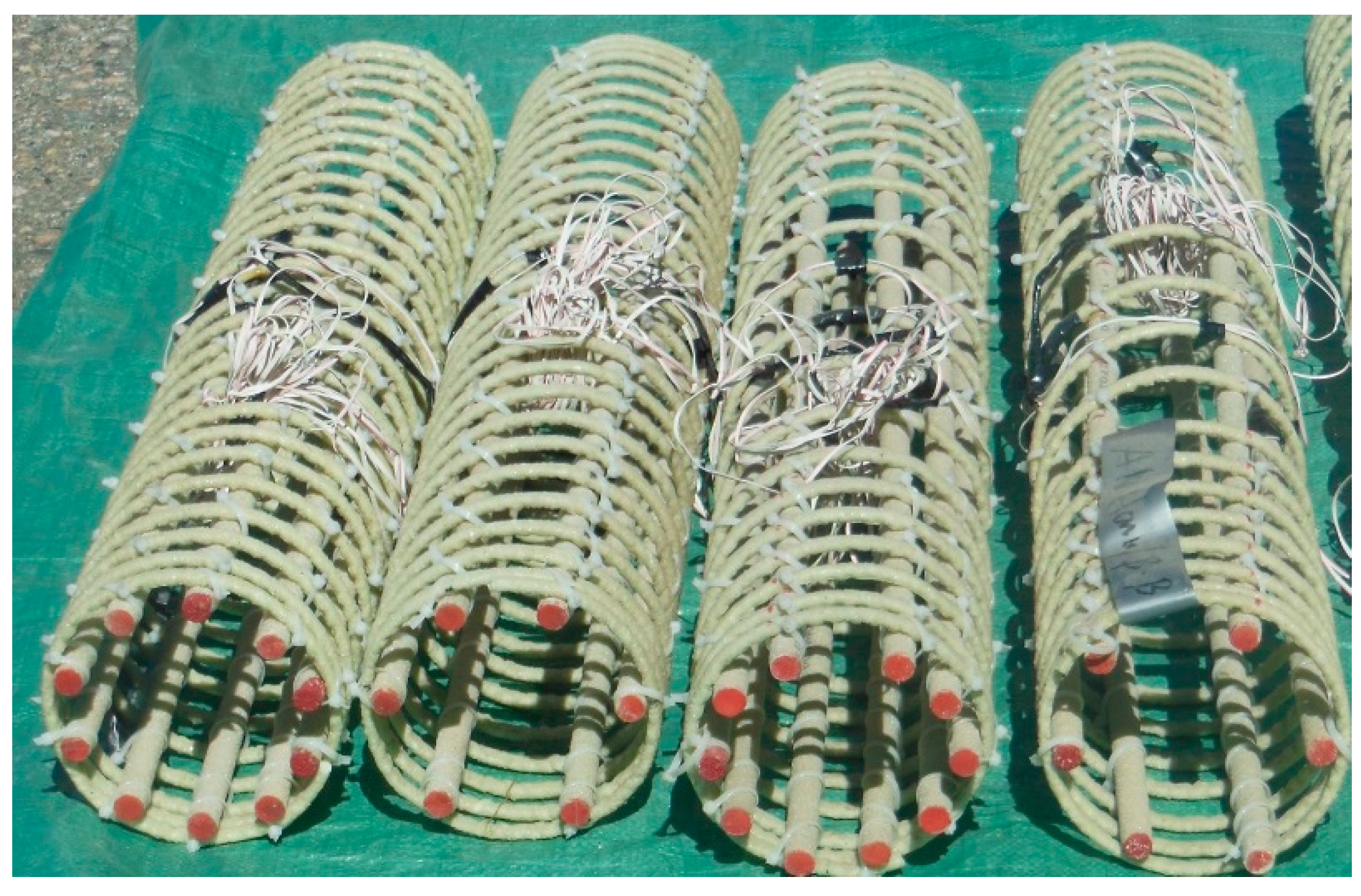


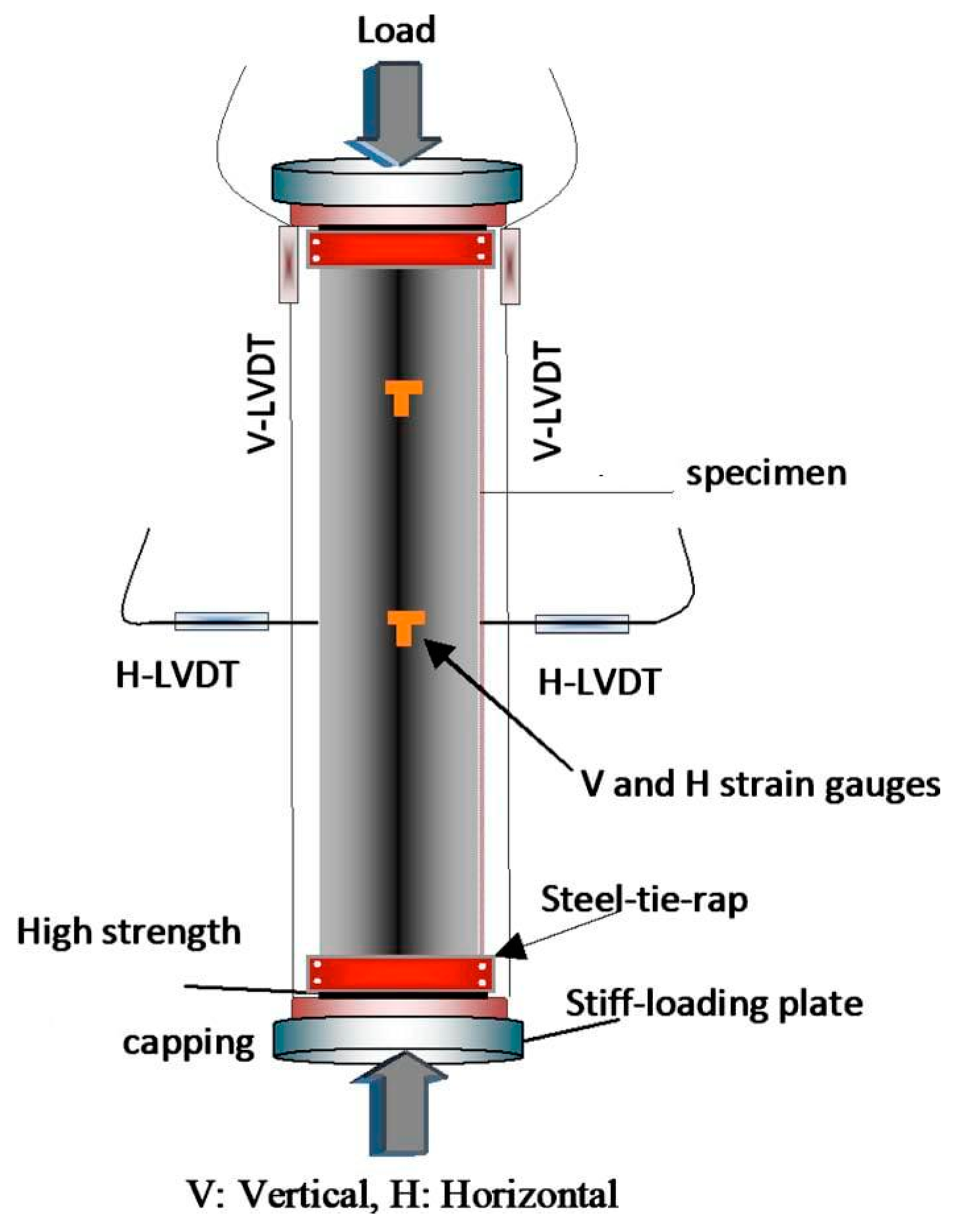


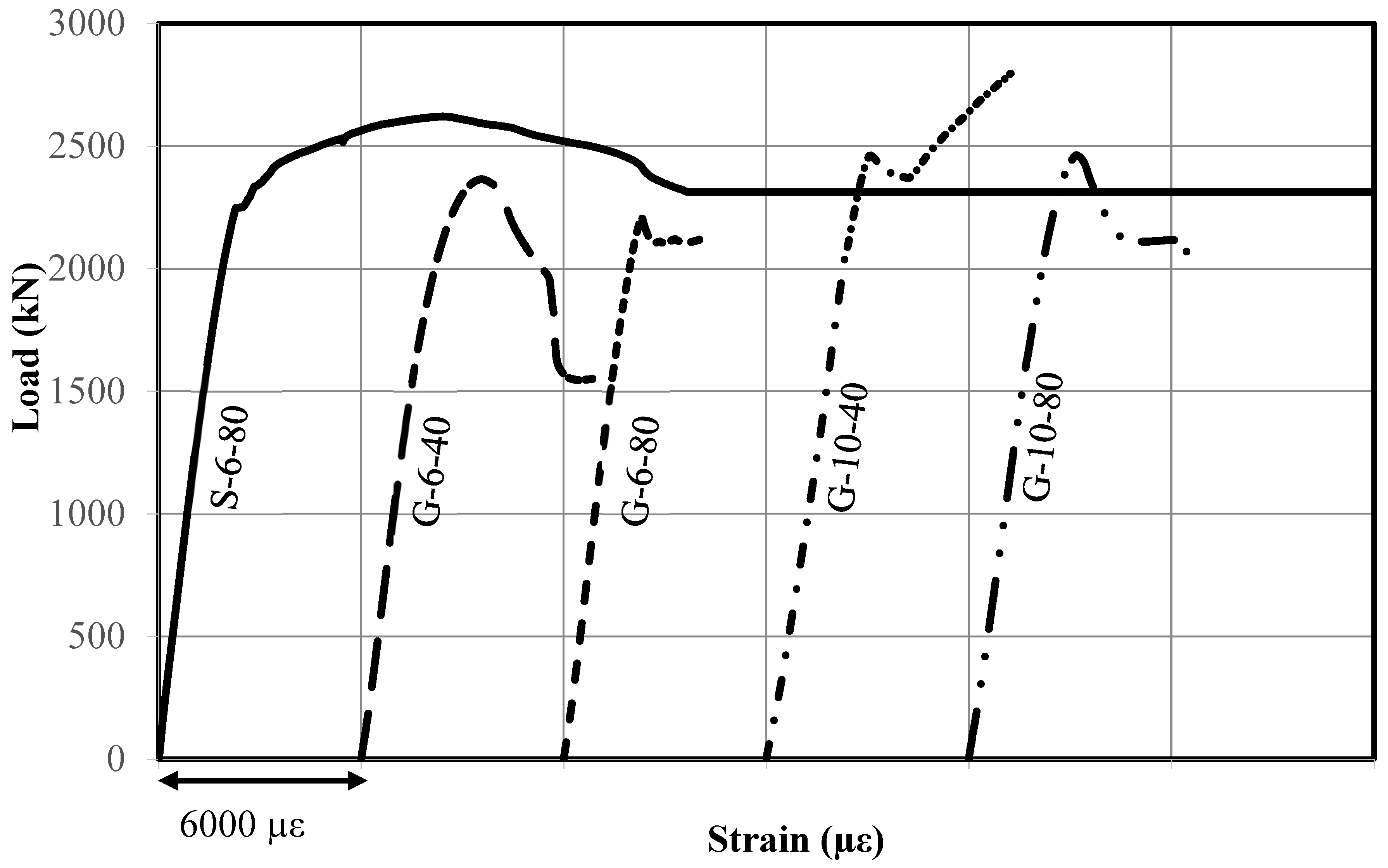
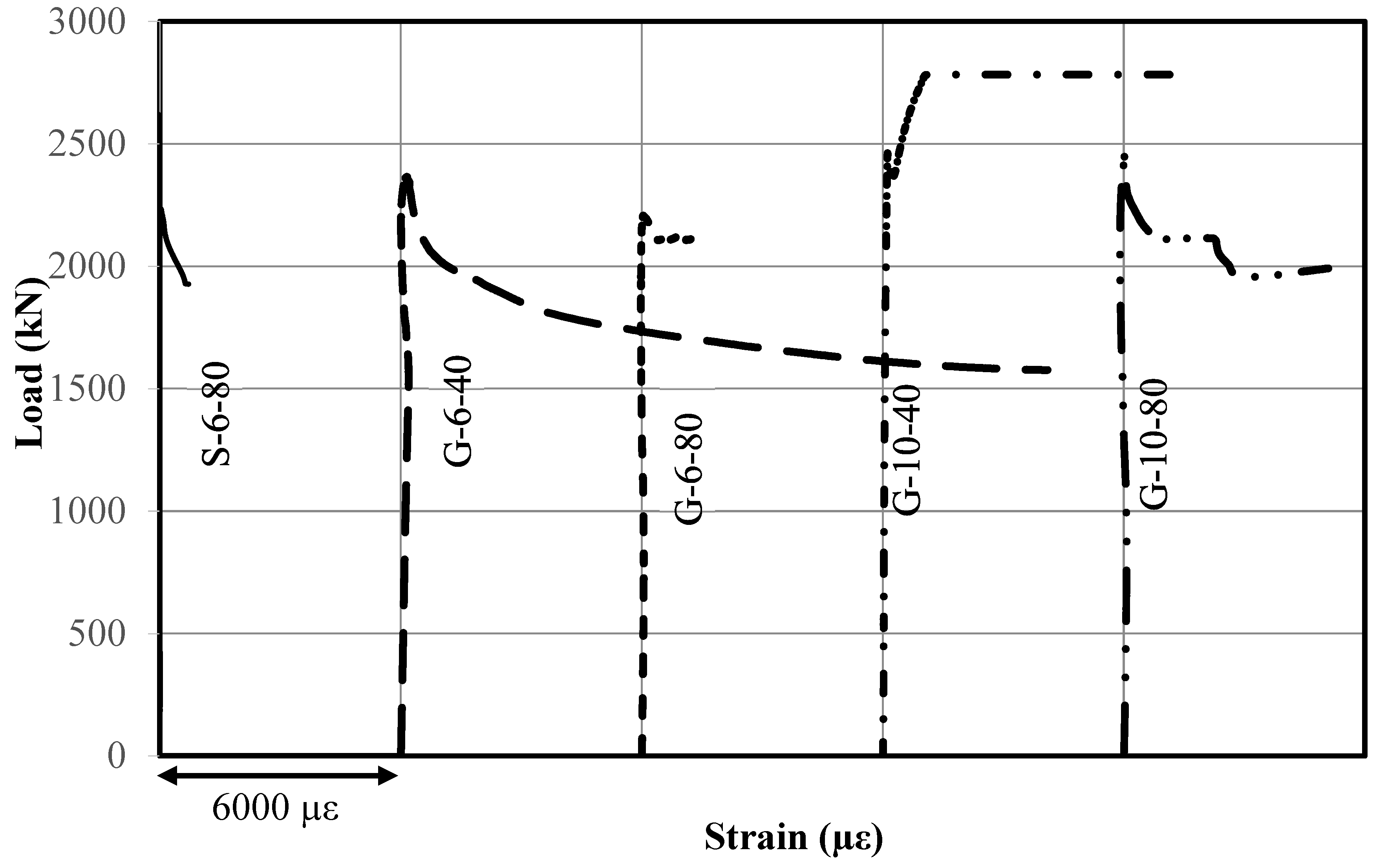
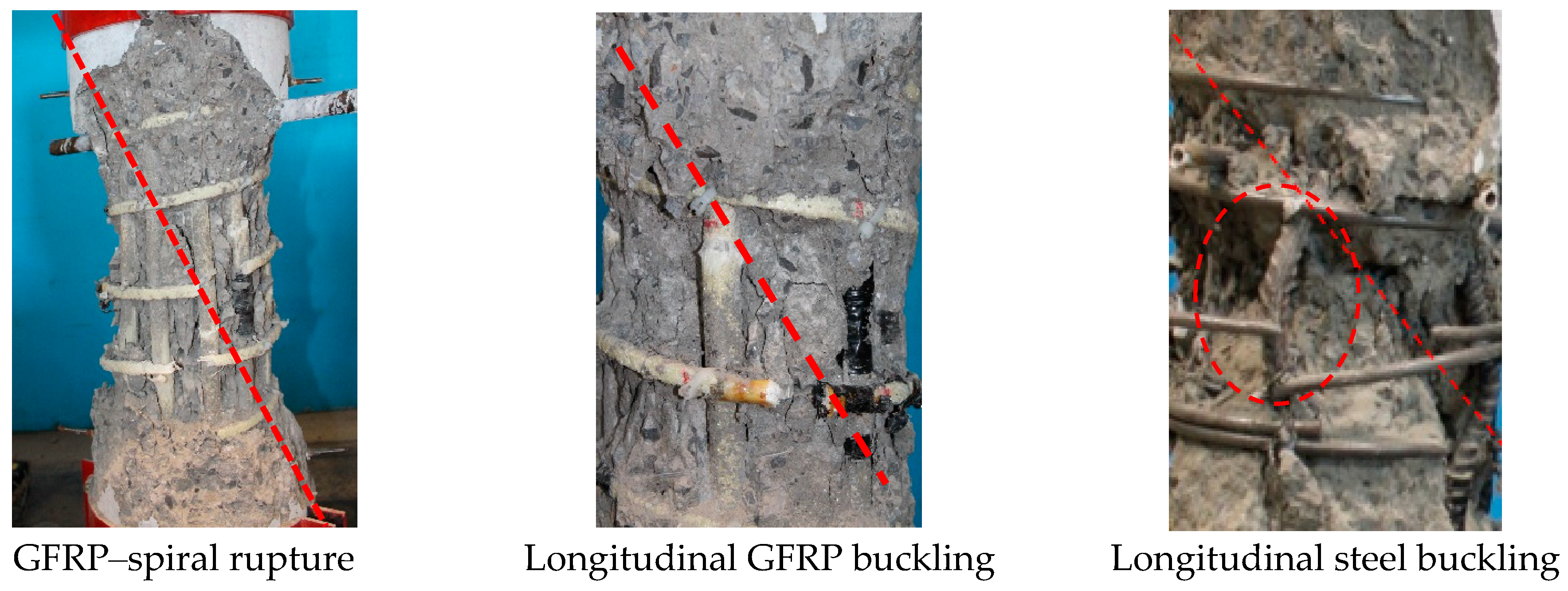
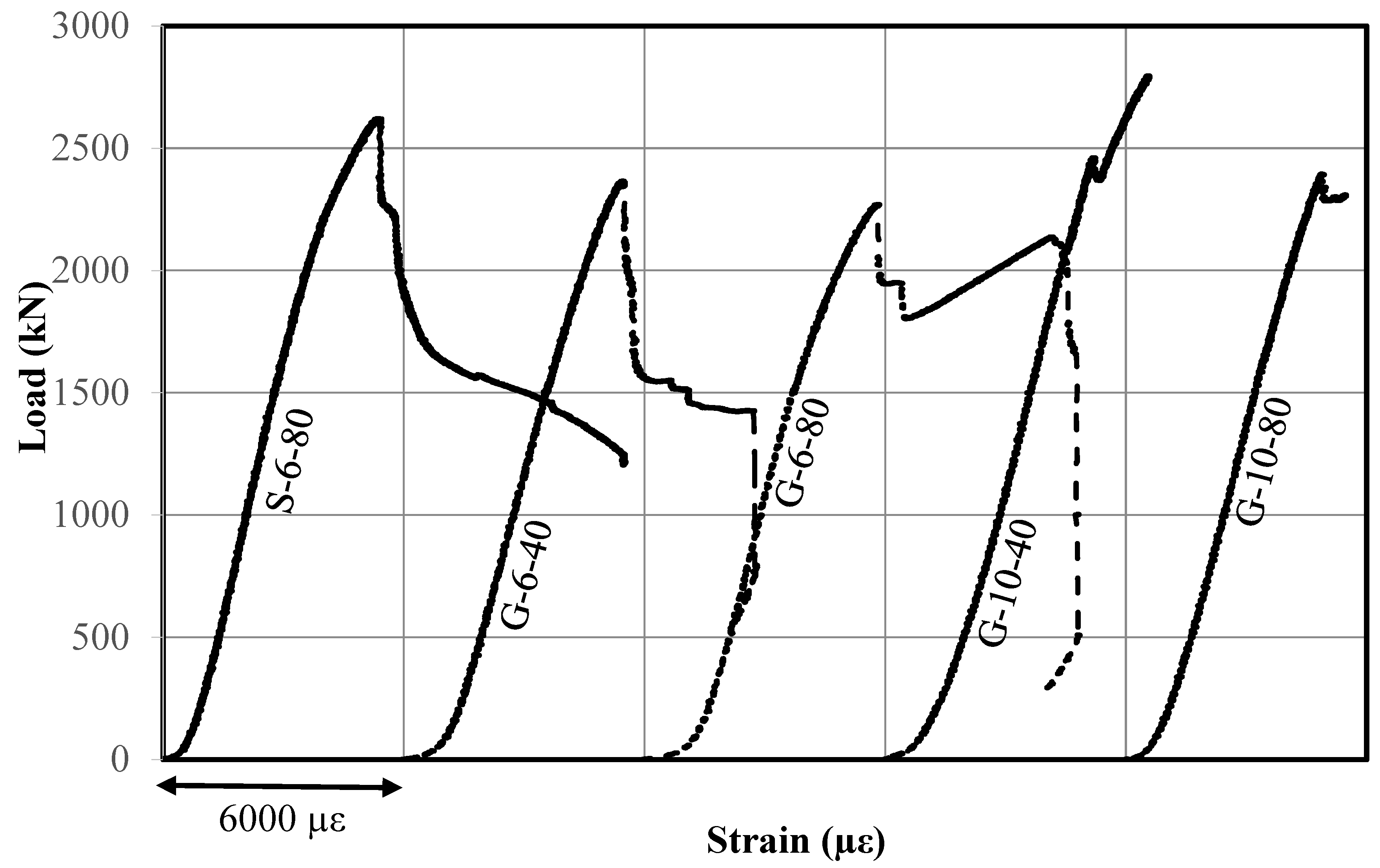
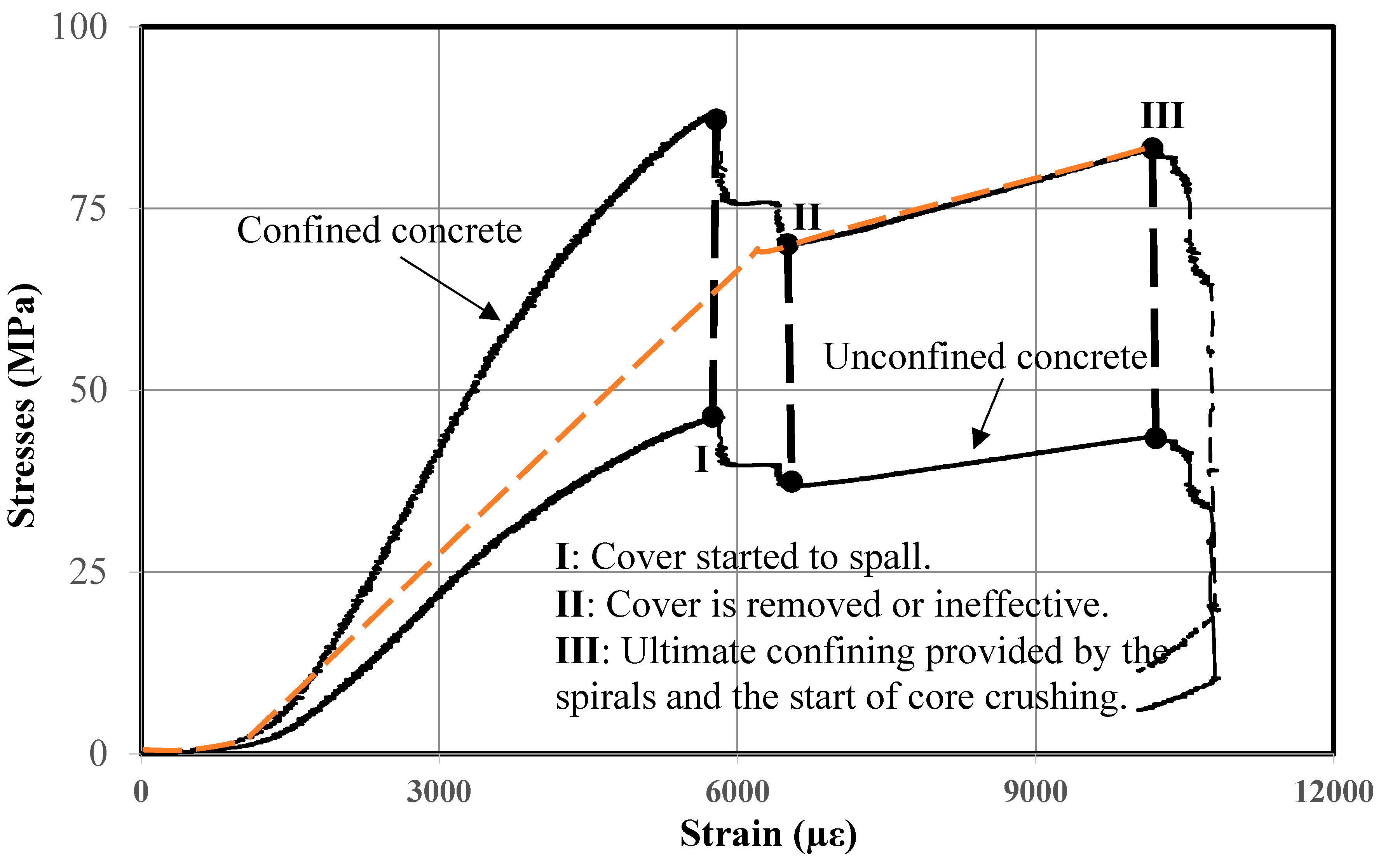
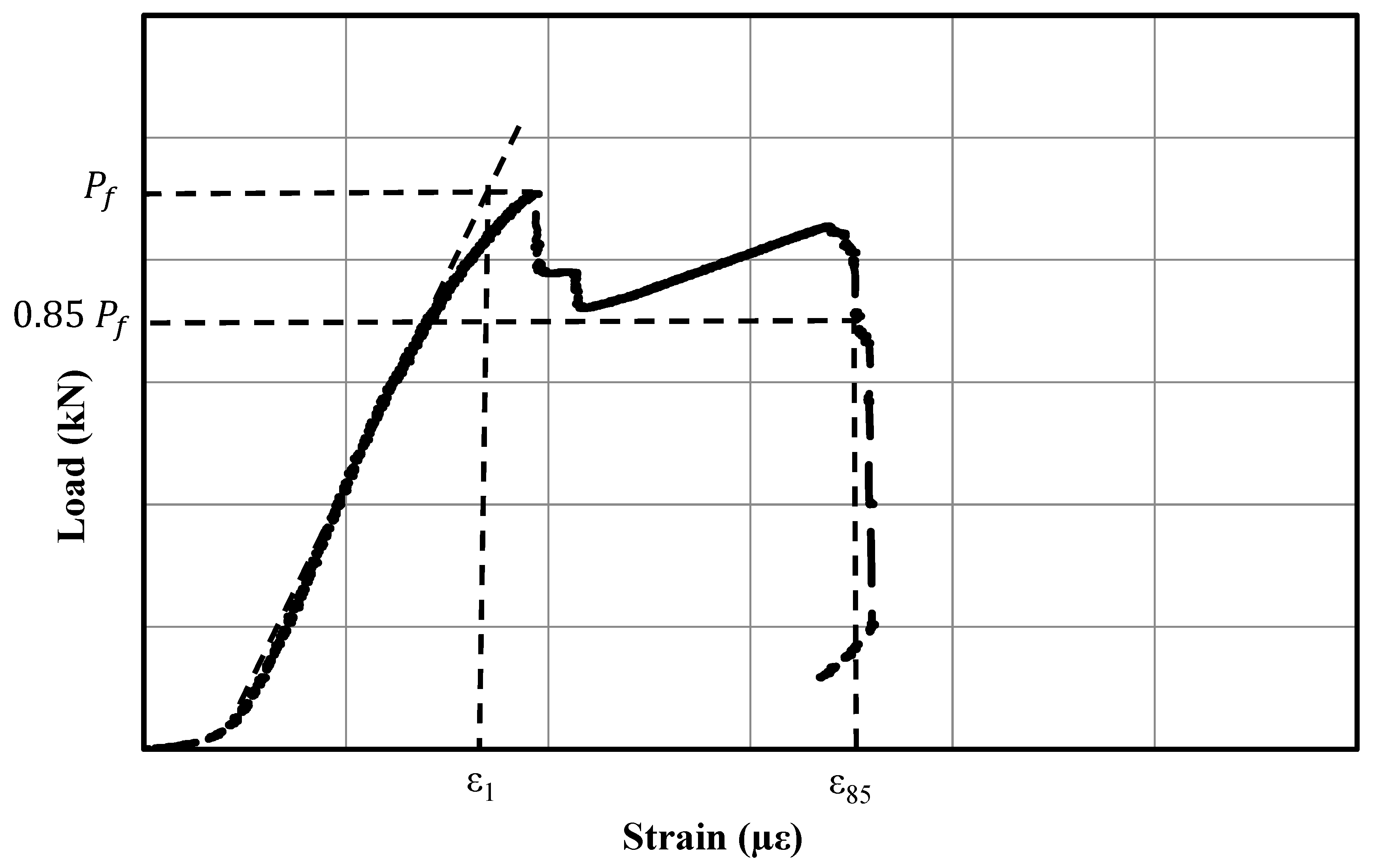

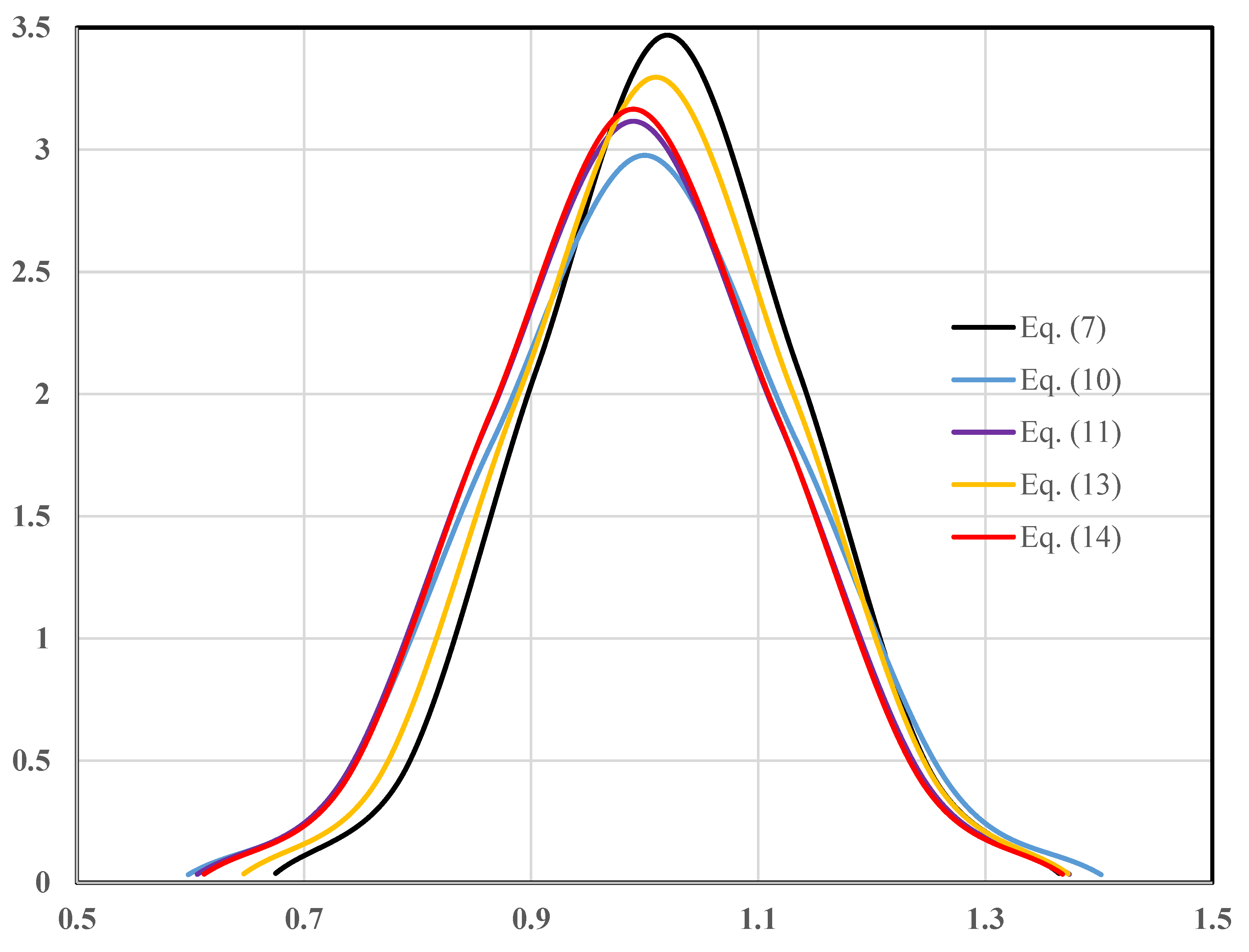
| Bar Size | Diameter (mm) | Area (mm2) | Elastic Tensile Modulus (GPa) | Tensile Strength (MPa) | Tensile Strain (%) |
|---|---|---|---|---|---|
| GFRP | |||||
| #3 | 9.5 | 71 | 53.4 | ffu = 889 | 1.66 |
| #5 | 15.9 | 199 | 55.4 | ffu = 934 | 1.68 |
| Steel | |||||
| M10 | 9.5 | 71 | 200 | fy = 460 | 0.23 |
| M15 | 16 | 200 | |||
| Column’s ID | (MPa) | Shear Reinforcement | Reinforcing Bars | ||
|---|---|---|---|---|---|
(%) | Pitch (mm) | Longitudinal | (%) | ||
| S-6-80 | 39.0 | 0.7 | 80 | 6 M15 | 2.4 |
| G-6-40 | 38.0 | 1.4 | 40 | 6 No. 5 | 2.4 |
| G-6-80 | 38.0 | 0.7 | 80 | 6 No. 5 | 2.4 |
| G-10-40 | 38.5 | 1.4 | 40 | 10 No. 5 | 4.0 |
| G-10-80 | 38.5 | 0.7 | 80 | 10 No. 5 | 4.0 |
| Column’s ID | Failure Load (kN) | Column’s Axial Strain at Peak Load (µε) | Concrete’s Strain at Peak Load (µε) | Longitudinal Reinforcement’s Strain at Peak Load (µε) | Spiral Reinforcement’s Strain at Peak Load (µε) | Ductility | |
|---|---|---|---|---|---|---|---|
| S-6-80 | 2621 | 5450 | 3147 | 8670 | 663 | 1.95 | 2.53 |
| G-6-40 | 2365 | 4880 | 3108 | 4069 | 125 | 1.86 | 1.10 |
| G-6-80 | 2207 | 5520 | 2236 | 2498 | 127 | 1.80 | 2.07 |
| G-10-40 | 2797 | 6610 | 2534 | 3325 | 7307 | 1.99 | - |
| G-10-80 | 2450 | 5860 | 2732 | 4009 | 250 | 1.90 | - |
| Column’s ID | ACI 440.11-22 [24] Forecast | CSA/S806-12 [27] Forecast | JSCE [28] Forecast | Equation (7) Forecast | ||||
|---|---|---|---|---|---|---|---|---|
(kN) | (kN) | (kN) | (kN) | |||||
| G-6-40 | 1584.7 | 1.49 | 1442.5 | 1.64 | 1584.7 | 1.49 | 1933.8 | 1.22 |
| G-6-80 | 1584.7 | 1.39 | 1442.5 | 1.53 | 1584.7 | 1.39 | 1799.6 | 1.23 |
| G-10-40 | 1605.6 | 1.74 | 1435.8 | 1.95 | 1605.6 | 1.74 | 2075.8 | 1.35 |
| G-10-80 | 1605.6 | 1.53 | 1435.8 | 1.71 | 1605.6 | 1.53 | 1941.7 | 1.26 |
Disclaimer/Publisher’s Note: The statements, opinions and data contained in all publications are solely those of the individual author(s) and contributor(s) and not of MDPI and/or the editor(s). MDPI and/or the editor(s) disclaim responsibility for any injury to people or property resulting from any ideas, methods, instructions or products referred to in the content. |
© 2024 by the authors. Licensee MDPI, Basel, Switzerland. This article is an open access article distributed under the terms and conditions of the Creative Commons Attribution (CC BY) license (https://creativecommons.org/licenses/by/4.0/).
Share and Cite
Alkhattabi, L.; Ali, A.H.; Mohamed, H.M.; Gouda, A. Strain Behavior of Short Concrete Columns Reinforced with GFRP Spirals. Buildings 2024, 14, 2180. https://doi.org/10.3390/buildings14072180
Alkhattabi L, Ali AH, Mohamed HM, Gouda A. Strain Behavior of Short Concrete Columns Reinforced with GFRP Spirals. Buildings. 2024; 14(7):2180. https://doi.org/10.3390/buildings14072180
Chicago/Turabian StyleAlkhattabi, Loai, Ahmed H. Ali, Hamdy M. Mohamed, and Ahmed Gouda. 2024. "Strain Behavior of Short Concrete Columns Reinforced with GFRP Spirals" Buildings 14, no. 7: 2180. https://doi.org/10.3390/buildings14072180






